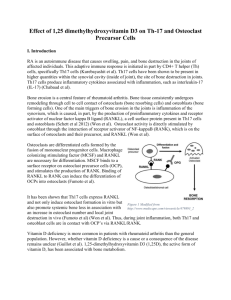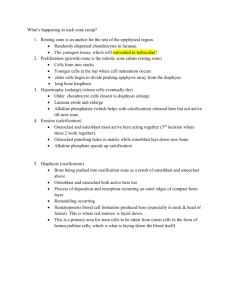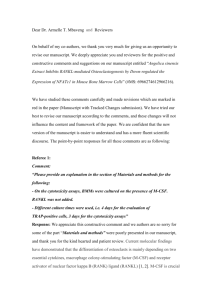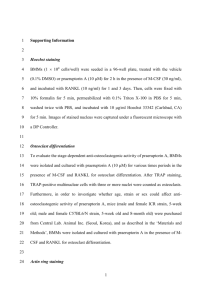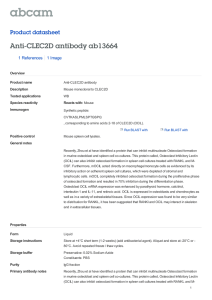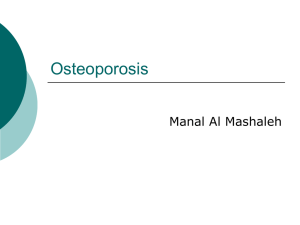Effect of 1,25 dimethylhydroxyvitamin D3 on Th-17
advertisement
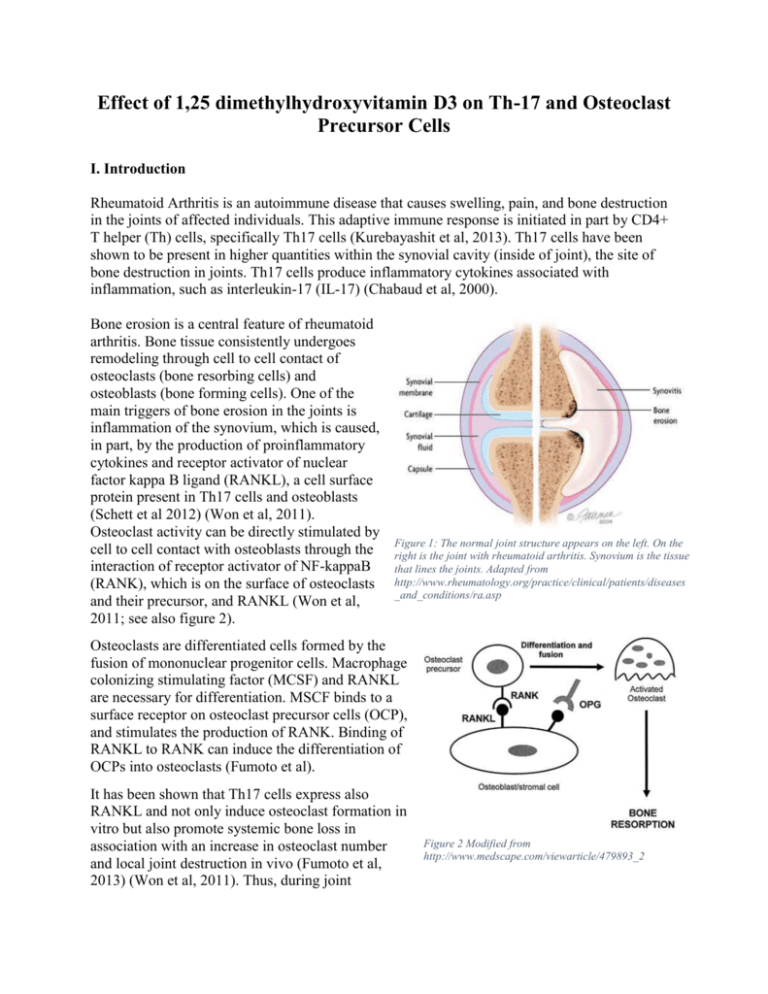
Effect of 1,25 dimethylhydroxyvitamin D3 on Th-17 and Osteoclast Precursor Cells I. Introduction Rheumatoid Arthritis is an autoimmune disease that causes swelling, pain, and bone destruction in the joints of affected individuals. This adaptive immune response is initiated in part by CD4+ T helper (Th) cells, specifically Th17 cells (Kurebayashit et al, 2013). Th17 cells have been shown to be present in higher quantities within the synovial cavity (inside of joint), the site of bone destruction in joints. Th17 cells produce inflammatory cytokines associated with inflammation, such as interleukin-17 (IL-17) (Chabaud et al, 2000). Bone erosion is a central feature of rheumatoid arthritis. Bone tissue consistently undergoes remodeling through cell to cell contact of osteoclasts (bone resorbing cells) and osteoblasts (bone forming cells). One of the main triggers of bone erosion in the joints is inflammation of the synovium, which is caused, in part, by the production of proinflammatory cytokines and receptor activator of nuclear factor kappa B ligand (RANKL), a cell surface protein present in Th17 cells and osteoblasts (Schett et al 2012) (Won et al, 2011). Osteoclast activity can be directly stimulated by cell to cell contact with osteoblasts through the interaction of receptor activator of NF-kappaB (RANK), which is on the surface of osteoclasts and their precursor, and RANKL (Won et al, 2011; see also figure 2). Figure 1: The normal joint structure appears on the left. On the right is the joint with rheumatoid arthritis. Synovium is the tissue that lines the joints. Adapted from http://www.rheumatology.org/practice/clinical/patients/diseases _and_conditions/ra.asp Osteoclasts are differentiated cells formed by the fusion of mononuclear progenitor cells. Macrophage colonizing stimulating factor (MCSF) and RANKL are necessary for differentiation. MSCF binds to a surface receptor on osteoclast precursor cells (OCP), and stimulates the production of RANK. Binding of RANKL to RANK can induce the differentiation of OCPs into osteoclasts (Fumoto et al). It has been shown that Th17 cells express also RANKL and not only induce osteoclast formation in vitro but also promote systemic bone loss in association with an increase in osteoclast number and local joint destruction in vivo (Fumoto et al, 2013) (Won et al, 2011). Thus, during joint Figure 2 Modified from http://www.medscape.com/viewarticle/479893_2 inflammation, both Th17 and osteoblast cells are in contact with OCP’s via the interaction of RANKL also RANK. Vitamin D deficiency is more common in patients with rheumatoid arthritis than the general population. However, whether vitamin D deficiency is a cause or a consequence of the disease remains unclear (Guillot et al, 2010). 1α,25-dimethylhydroxyvitamin D3 (1,25D), the active form of vitamin D, has been associated with bone metabolism. Kim et al reported that 1,25D inhibited osteoclastogenesis in OCP samples by down-regulating RANK expression. They produced their data by treating OCPs with MCSF, RANKL, and 1,25D. They used quantitative reverse transcription PCR to measured relative mRNA levels of TRAP, an enzyme that is only produced by osteoclasts. Bone erosion, caused by mature osteoclast cells, is common in patients with rheumatoid arthritis. Activated T helper cells such as Th1, Th2, and Th17 are found in the synovial cavity during the time of inflammation due to rheumatoid arthritis. The known mechanisms associated with the differentiation of osteoclast precursors into mature osteoclasts involve the signaling molecules produced by immune-associate cells, as well as the direct cell to cell contact of osteoblasts and osteoclast precursors. However, it has been suggested that Th17 can also play a more major role in osteoclast differentiation via cell to cell contact with osteoclast precursors. The purpose of this experiment is to examine the effect of 1,25D on OCP cells in the presence of Th-17 cells by measuring TRAP mRNA in osteoclasts. II. The Experiment This experiment will examine the effect of 1,25D on OCP cells in the presence of Th-17 cells. This will be accomplished by measuring the relative amounts of TRAP positive osteoclasts with the use of quantitative reverse transcriptase PCR on the osteoclast marker enzyme TRAP (as described by Balani et al). GAPDH will be used as a reference gene. Kim et al (2013) used human osteoclast precursors from normal peripheral blood that were cultured in MCSF. This stimulates the growth of RANK on the surface of the OCP’s. Then, they treated the OCP’s with RANKL, which is expected to induce osteoclast development. Three separate studies were done with the samples. 1,25D was added from 0-8, 2-8, and 5-8 days. TRAP expression in the resulting osteoclasts were analyzed using real-time PCR, measured in %GAPDH. Relative mRNA of TRAP in RANKL negative samples are between 200 and 300, while the RANKL positive samples had a relative mRNA >50. In this experiment, relative TRAP mRNA will be measured after treatment of 1,25D in a co-culture of osteoclast precursor cells and Th-17 cells. Figure 3: Expression of TRAP mRNA of OCP's treated with RANKL, with or without 1,25D. Modified from Kim et al (2013) Osteoclast precursor cells, derived from human peripheral blood mononuclear cells (Kim et al), will be incubated in MCSF. This will stimulate the production of RANK. Th-17 cells will then be added with or without 1,25D. To access whether differentiation of osteoclasts occurred, quantitative real-time PCR will be used to measure the relative amounts of TRAP mRNA, using GAPDH as a reference (as described by Kim et al) III Discussion Considering that both osteoblasts and Th17 cells produce RANKL and interact with OCP’s in a similar fashion, I expect the relative TRAP mRNA to be lower in sample containing 1,25D. The 1,25D negative sample should have increased TRAP mRNA, however, not as much as the 1,25D negative sample in the Kim et al experiment. In the case that TRAP mRNA levels are higher, a possible explanation would be that Th17 cells may express more RANKL than osteoblasts. On the other hand, if Th17 cells produce less RANKL, or not enough for a significant reaction, then TRAP might not be detectable from PCR. Since the experiment is being performed in vitro, the expression of MSCF starts at day 0, thus giving the reaction a chance to occur. However, in reality, the amount of MSCF or RANK present in joints might prevent the reaction from occurring altogether. If the results from this experiment show at least a 2 to 3 fold decrease in TRAP mRNA and a parallel decrease in TRAP protein expression (method not discussed), an experiment could be performed to test the mechanism’s significance in a collagen induced arthritis mouse model, perhaps using T cell specific RANKL deficient mice. IV. References 1. Chabaud M, Garnero P, Dayer JM, Guerne P a, Fossiez F, Miossec P. Contribution of interleukin 17 to synovium matrix destruction in rheumatoid arthritis. Cytokine. 2000;12(7):1092–9. Available at: http://www.ncbi.nlm.nih.gov/pubmed/10880256. Accessed December 8, 2013. 2. Balani D, Aeberli D, Hofstetter W, Seitz M. Interleukin-17A stimulates granulocytemacrophage colony-stimulating factor release by murine osteoblasts in the presence of 1,25dihydroxyvitamin D(3) and inhibits murine osteoclast development in vitro. Arthritis Rheum. 2013;65(2):436–46. Available at: http://www.ncbi.nlm.nih.gov/pubmed/23124514. Accessed November 13, 2013. 3. Bouillon R, Carmeliet G, Verlinden L, et al. Vitamin D and human health: lessons from vitamin D receptor null mice. Endocr. Rev. 2008;29(6):726–76. Available at: http://www.pubmedcentral.nih.gov/articlerender.fcgi?artid=2583388&tool=pmcentrez&renderty pe=abstract. 4. Chakravarty SD, Poulikakos PI, Ivashkiv LB, Salmon JE, Kalliolias GD. Kinase inhibitors: a new tool for the treatment of rheumatoid arthritis. Clin. Immunol. 2013;148(1):66–78. Available at: http://www.ncbi.nlm.nih.gov/pubmed/23651870. Accessed December 1, 2013. 5. Fumoto T, Takeshita S, Ito M, Ikeda K. Physiological functions of osteoblast lineage and T cell-derived RANKL in bone homeostasis. J. Bone Miner. Res. 2013. Available at: http://www.ncbi.nlm.nih.gov/pubmed/24014480. Accessed December 1, 2013. 6. Gravallese GS& E. Bone erosion in rheumatoid arthritis: mechanisms, diagnosis and treatment. 2012:8, 656–664. 7. Guillot X, Semerano L, Saidenberg-Kermanac’h N, Falgarone G, Boissier M-C. Vitamin D and inflammation. Joint. Bone. Spine. 2010;77(6):552–7. Available at: http://www.ncbi.nlm.nih.gov/pubmed/21067953. Accessed November 15, 2013. 8. Kim T-H, Lee B, Kwon E, et al. 1,25-Dihydroxyvitamin D3 inhibits directly human osteoclastogenesis by down-regulation of the c-Fms and RANK expression. Joint. Bone. Spine. 2013;80(3):307–14. Available at: http://www.ncbi.nlm.nih.gov/pubmed/23116709. Accessed November 19, 2013. 9. Kurebayashi Y, Nagai S, Ikejiri A, Koyasu S. Recent advances in understanding the molecular mechanisms of the development and function of Th17 cells. Genes Cells. 2013;18(4):247–65. Available at: http://www.pubmedcentral.nih.gov/articlerender.fcgi?artid=3657121&tool=pmcentrez&renderty pe=abstract. Accessed November 12, 2013. 10. Lee PP, Fitzpatrick DR, Beard C, et al. A critical role for Dnmt1 and DNA methylation in T cell development, function, and survival. Immunity. 2001;15(5):763–74. Available at: http://www.ncbi.nlm.nih.gov/pubmed/11728338. 11. Suda T, Jimi E, Nakamura I, Takahashi N. Role of 1 alpha,25-dihydroxyvitamin D3 in osteoclast differentiation and function. Methods Enzymol. 1997;282(1992):223–35. Available at: http://www.ncbi.nlm.nih.gov/pubmed/10384146. 12. Wang R, Zhang L, Zhang X, et al. Regulation of activation-induced receptor activator of NFkappaB ligand (RANKL) expression in T cells. Eur. J. Immunol. 2002;32(4):1090–8. Available at: http://www.ncbi.nlm.nih.gov/pubmed/11920576. 13. Won HY, Lee J-A, Park ZS, et al. Prominent bone loss mediated by RANKL and IL-17 produced by CD4+ T cells in TallyHo/JngJ mice. PLoS One. 2011;6(3):e18168. Available at: http://www.pubmedcentral.nih.gov/articlerender.fcgi?artid=3064589&tool=pmcentrez&renderty pe=abstract. Accessed December 1, 2013.
